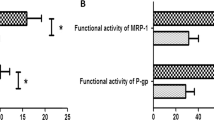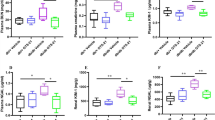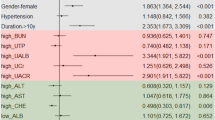Abstract
Digoxin is eliminated mainly by the kidney through glomerular filtration and P-glycoprotein (P-gp) mediated tubular secretion. Toddlers and young children require higher doses of digoxin per kilogram of bodyweight than adults, although the reasons for this have not been elucidated. We hypothesized there is an age-dependant increase in P-gp expression in young children. The objectives of this study were to elucidate age-dependant expression of renal P-gp and its correlation with changes in the clearance rate of digoxin. FVB mice were killed at different ages to prepare total RNA for P-gp expression studies. Semi-quantitative RT-PCR was conducted to analyze mdr1a and mdr1b ontogeny in the kidney at: birth, 7, 14, 21, 28 and 45-d old adults. The pharmacokinetics of digoxin (7 μg/kg) was studied in mice of the same age groups. Newborn and Day 7 levels of both mdr1a and mdr1b were marginal. Day 21 mdr1b levels were significantly higher than both Day 14 and Day 28 levels. Digoxin clearance rates were the highest at Day 21, with significant correlation between P-gp expression and clearance values. Increases in digoxin clearance rates after weaning may be attributed, at least in part, to similar increases in P-gp expression.
Similar content being viewed by others
Log in or create a free account to read this content
Gain free access to this article, as well as selected content from this journal and more on nature.com
or
Abbreviations
- IDV:
-
integrated density value
- p-gp:
-
P-glycoprotein
References
Kauffman RE 2005 Drug action and therapy in infants and children. In: Yaffe SJ, Aranda JV (eds) Neonatal and pediatric pharmacology. Lippincott Williams and Wilkins, Philadelphia, pp 20–31
Morselli PL 1975 Digoxin pharmacokinetics during human development. In: Morselli PL, Garattini S, Sereni F (eds) Basic and therapeutic aspects of perinatal pharmacology. Raven Press, New York, pp 377–392
Nyberg L, Wettrell G 1978 Digoxin dosage schedules for neonates and infants based on pharmacokinetic considerations. Clin Pharmacokinet 3: 453–461
Bendayan R 1996 Renal drug transport: a review. Pharmacotherapy 16: 971–985
Croop JM, Raymond M, Haber D, Devault A, Arceci RJ, Gros P, Housman DE 1989 The three mouse multidrug resistance (mdr) genes are expressed in a tissue-specific manner in normal mouse tissues. Mol Cell Biol 9: 1346–1350
Devault A, Gros P 1990 Two members of the mouse mdr gene family confer multidrug resistance with overlapping but distinct drug specificities. Mol Cell Biol 10: 1652–63
Hsu SI, Lothstein L, Horwitz SB 1989 Differential overexpression of three mdr gene family members in multidrug-resistant J774.2 mouse cells. Evidence that distinct P-glycoprotein precursors are encoded by unique mdr genes. J Biol Chem 264: 12053–12062
Schinkel AH, Smit JJ, van Tellingen O, Beijnen JH, Wagenaar E, van Deemter L, Mol CA, van der Valk MA, Robanus-Maandag EC, te Riele HP 1994 Disruption of the mouse mdr1a P-glycoprotein gene leads to a deficiency in the blood-brain barrier and to increased sensitivity to drugs. Cell 77: 491–502
Gros P, Raymond M, Bell J, Housman D 1988 Cloning and characterization of a second member of the mouse mdr gene family. Mol Cell Biol 8: 2770–2778
Schiengold M, Schwantes L, Schwartsmann G, Chies JA, Nardi NB 2001 Multidrug resistance gene expression during the murine ontogeny. Mech Ageing Dev 122: 255–270
Kawahara M, Sakata A, Miyashita T, Tamai I, Tsuji A 1999 Physiologically based pharmacokinetics of digoxin in mdr1a knockout mice. J Pharm Sci 88: 1281–1287
Stephens RH, O'Neill CA, Bennett J, Humphrey M, Henry B, Rowland M, Warhurst G 2002 Resolution of P-glycoprotein and non-P-glycoprotein effects on drug permeability using intestinal tissues from mdr1a (−/−) mice. Br J Pharmacol 135: 2038–2046
Mahmood B, Daood MJ, Hart C, Hansen TW, Watchko JF 2001 Ontogeny of P-glycoprotein in mouse intestine, liver, and kidney. J Investig Med 49: 250–257
Tsuruoka S, Sugimoto KI, Fujimura A, Imai M, Asano Y, Muto S 2001 P-glycoprotein-mediated drug secretion in mouse proximal tubule perfused in vitro. J Am Soc Nephrol 12: 177–181
Fromm MF, Kim RB, Stein CM, Wilkinson GR, Roden DM 1999 Inhibition of P-glycoprotein-mediated drug transport: a unifying mechanism to explain the interaction between digoxin and quinidine. Circulation 99: 552–557
De Lannoy IA, Koren G, Klein J, Charuk J, Silverman M 1992 Cyclosporin and quinidine inhibition of renal digoxin excretion: evidence for luminal secretion of digoxin. Am J Physiol 263: F613–F622
Ito S, Woodland C, Harper PA, Koren G 1993 P-glycoprotein-mediated renal tubular secretion of digoxin: the toxicological significance of the urine-blood barrier model. Life Sci 53: PL25–PL31
Koren G, Woodland C, Ito S 1998 Toxic digoxin-drug interactions: the major role of renal P-glycoprotein. Vet Hum Toxicol 40: 45–46
Woodland C, Ito S, Koren G 1998 A model for the prediction of digoxin-drug interactions at the renal tubular cell level. Ther Drug Monit 20: 134–138
Woodland C, Koren G, Ito S 2003 From bench to bedside: utilization of an in vitro model to predict potential drug-drug interactions in the kidney: the digoxin-mifepristone example. J Clin Pharmacol 43: 743–750
Dutt A, Priebe TS, Teeter LD, Kuo MT, Nelson JA 1992 Postnatal development of organic cation transport and mdr gene expression in mouse kidney. J Pharmacol Exp Ther 261: 1222–1230
Rosati A, Maniori S, Decorti G, Candussio L, Giraldi T, Bartoli F 2003 Physiological regulation of P-glycoprotein, MRP1, MRP2 and cytochrome P450 3A2 during rat ontogeny. Dev Growth Differ 45: 377–387
Taipalensuu J, Tavelin S, Lazorova L, Svensson AC, Artursson P 2004 Exploring the quantitative relationship between the level of MDR1 transcript, protein and function using digoxin as a marker of MDR1-dependent drug efflux activity. Eur J Pharm Sci 21: 69–75
Tanigawara Y 2000 Role of P-glycoprotein in drug disposition. Ther Drug Monit 22: 137–140
Rane A 2005 Drug metabolism and disposition in infants and children. In: Yaffe SJ, Aranda JV (eds) Neonatal and pediatric pharmacology. Lippincott Williams and Wilkins, Philadelphia, pp 32–43
Noe B, Hagenbuch B, Stieger B, Meier PJ 1997 Isolation of a multispecific organic anion and cardiac glycoside transporter from rat brain. Proc Natl Acad Sci USA 94: 10346–10350
Mikkaichi T, Suzuki T, Onogawa T, Tanemoto M, Mizutamari H, Okada M, Chaki T, Masuda S, Tokui T, Eto N, Abe M, Satoh F, Unno M, Hishinuma T, Inui K, Ito S, Goto J, Abe T 2004 Isolation and characterization of a digoxin transporter and its rat homologue expressed in the kidney. Proc Natl Acad Sci USA 101: 3569–3574
Potter EL 1965 Development of the human glomerulus. Arch Pathol 80: 241–255
West JR, Smith HW, Chasis H 1948 Glomerular filtration rate, effective renal blood flow and maximal tubular excretory capacity in infancy. J Pediatr 32: 10–18
Alcorn J, McNamara PJ 2002 Ontogeny of hepatic and renal systemic clearance pathways in infants: part I. Clin Pharmacokinet 41: 959–998
Morselli PL, Franco-Morselli R, Bossi L 1980 Clinical pharmacokinetics in newborns and infants: Age-related differences and therapeutic implications. Clin Pharmacokinet 5: 485–527
Lothstein L, Hsu SI, Horwitz SB, Greenberger LM 1989 Alternate overexpression of two P-glycoprotein [corrected] genes is associated with changes in multidrug resistance in a J774.2 cell line. J Biol Chem 264: 16054–16058
Yang JM, Sullivan GF, Hait WN 1997 Regulation of the function of P-glycoprotein by epidermal growth factor through phospholipase C. Biochem Pharmacol 53: 1597–1604
Chen C, Liu X, Smith BJ 2003 Utility of Mdr1-gene deficient mice in assessing the impact of P-glycoprotein on pharmacokinetics and pharmacodynamics in drug discovery and development. Curr Drug Metab 4: 272–291
Acknowledgements
We would like to thank Christopher Paciorek for technical assistance and the staff of the Laboratory Animal Services for their care of animals used in this study. NP was awarded the American Society for Clinical Pharmacology and Therapeutics' Presidential Trainee Award for this work (Miami, Florida, March 2004).
Author information
Authors and Affiliations
Corresponding author
Additional information
Supported by a grant from the Canadian Institutes of Health Research (CIHR). Dr. Gideon Koren is holder of the Ivey Chair in Molecular Toxicology, University of Western Ontario.
Rights and permissions
About this article
Cite this article
Pinto, N., Halachmi, N., Verjee, Z. et al. Ontogeny of Renal P-glycoprotein Expression in Mice: Correlation with Digoxin Renal Clearance. Pediatr Res 58, 1284–1289 (2005). https://doi.org/10.1203/01.pdr.0000188697.99079.27
Received:
Accepted:
Issue date:
DOI: https://doi.org/10.1203/01.pdr.0000188697.99079.27
This article is cited by
-
Pharmacokinetics in children with chronic kidney disease
Pediatric Nephrology (2020)
-
Development of Human Membrane Transporters: Drug Disposition and Pharmacogenetics
Clinical Pharmacokinetics (2016)
-
Development of a Paediatric Population-Based Model of the Pharmacokinetics of Rivaroxaban
Clinical Pharmacokinetics (2014)
-
Risperidone and Paliperidone Inhibit P-Glycoprotein Activity In Vitro
Neuropsychopharmacology (2007)



